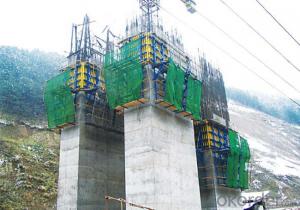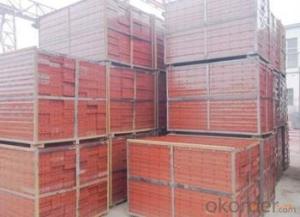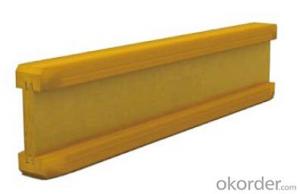Climbing bracket CB240 for formwork and scaffolding systems
- Loading Port:
- Tianjin
- Payment Terms:
- TT OR LC
- Min Order Qty:
- 50 m²
- Supply Capability:
- 1000 m²/month
OKorder Service Pledge
OKorder Financial Service
You Might Also Like
Climbing Bracket CB240 & CB210
They are framework brackets for supporting large-area wall formwork.
Typical applications for the CB240&CB210 are pier and column/shear wall/core walll/ in the
building.
CB210 has smaller size than CB240, it will be cost effective in some condition.
Characteristics:
◆ High bearing capacity
The high loading capacity of the brackets allow very large scaffold units. This saves the number
anchor points required as well as reducing climbing times.
◆ Simple moving procedure by crane
Through the strong connection of formwork together with the climbing scaffold, both can be moved
as a single climbing unit by crane. Thus valuable time-savings can be achieved.
◆ Fast striking process without a crane
With the retrusive set, large formwork elements can also be retracted quickly and a minimum of
effort.
◆ Safe with work platform
The platforms have assembled firmly with bracket and will be climbing together, without scaffolding
but can work safely in spite of your high location.
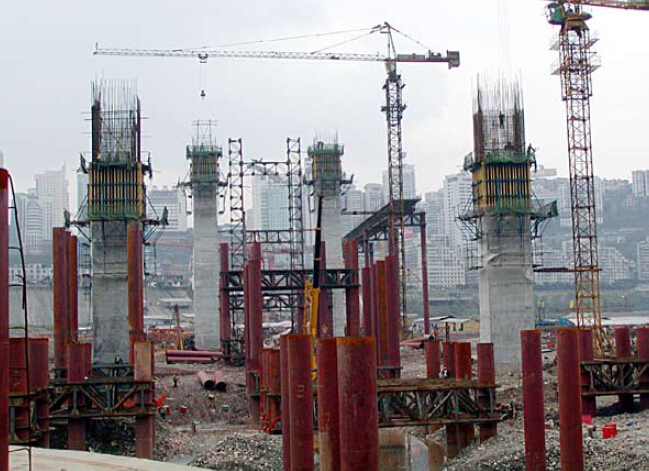
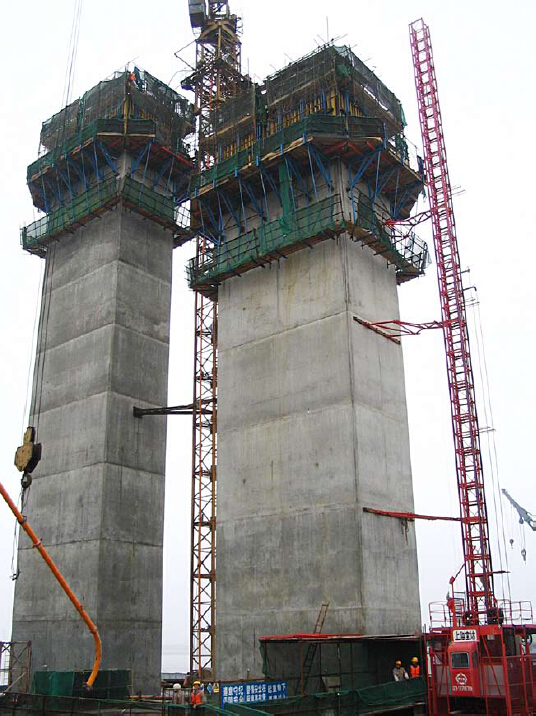
- Q: Can steel formwork be used for both straight and curved structures?
- Yes, steel formwork can be used for both straight and curved structures. It can be easily adjusted and shaped to accommodate various design requirements, making it versatile for construction projects that involve both straight and curved elements.
- Q: What are the common quality control measures for steel formwork systems?
- Steel formwork systems commonly undergo several quality control measures to ensure their effectiveness and safety in construction projects. These measures include: 1. Visual assessment: A thorough examination of the steel formwork system's condition is conducted to identify any noticeable defects, such as dents, cracks, or deformations. Damaged or compromised components must be promptly repaired or replaced. 2. Measurement and dimensional verification: Ensuring accurate measurements and dimensional alignment of steel formwork components is crucial. This is achieved by utilizing precise measuring tools and equipment to guarantee a proper fit. 3. Inspection of welded joints: Since welded joints are often used to connect various components of steel formwork systems, it is vital to conduct comprehensive inspections to detect any defects, like cracks or incomplete penetration. Non-destructive testing methods, such as visual inspection, ultrasonic testing, or magnetic particle testing, may be employed to evaluate the weld quality. 4. Load testing: To validate the structural integrity and load-bearing capacity, load testing is performed. This procedure involves applying a predetermined load to the system and evaluating its performance under stress. It helps identify any weaknesses or defects that could compromise the formwork's safety and stability. 5. Examination of surface finish: The surface finish of steel formwork systems must be smooth and devoid of roughness or irregularities that could affect the quality of the concrete finish. Inspections are carried out to ensure that the formwork surfaces are adequately cleaned, treated, and coated, if necessary. 6. Documentation and traceability: It is imperative to maintain proper documentation and traceability of the steel formwork system components. This includes keeping records of inspections, repairs, replacements, and other pertinent information. Proper documentation ensures timely and accurate resolution of any issues or concerns that may arise. These quality control measures are indispensable for guaranteeing the durability, safety, and performance of steel formwork systems in construction projects.
- Q: What are the different types of formwork clamps used in steel formwork?
- There are several types of formwork clamps that are commonly used in steel formwork construction. These clamps are designed to securely hold the formwork panels together, ensuring stability and accuracy during the concrete pouring process. 1. Wedge Clamps: Wedge clamps are one of the most commonly used formwork clamps. These clamps consist of a wedge-shaped piece that is inserted into a slot on the formwork panel. As the wedge is driven further into the slot, it creates a tight and secure connection between the panels. 2. Rapid Clamps: Rapid clamps are a type of formwork clamp that allows for quick and easy installation and removal. They are designed with a spring-loaded mechanism that allows the clamp to be easily tightened or loosened with minimal effort. 3. Turnbuckle Clamps: Turnbuckle clamps are adjustable clamps that are used to provide additional tension and support to the formwork panels. These clamps consist of a threaded rod with a turnbuckle mechanism that can be tightened or loosened to adjust the tension on the formwork. 4. Pipe Clamps: Pipe clamps are a type of formwork clamp that uses pipes or tubes to connect and secure the formwork panels. These clamps typically consist of a U-shaped bracket that is attached to the formwork panel and a pipe or tube that is inserted into the bracket to hold the panels together. 5. Panel Clamps: Panel clamps are specifically designed to hold large formwork panels together. These clamps typically consist of a large, heavy-duty clamp that can be tightened or loosened to securely hold the panels in place. Each type of formwork clamp has its own unique features and advantages, and the choice of clamp will depend on factors such as the size and weight of the formwork panels, the desired level of stability, and the specific requirements of the construction project.
- Q: Can steel formwork be used in combination with other types of formwork?
- Yes, steel formwork can be used in combination with other types of formwork. In construction projects, it is common to use a combination of different types of formwork to meet the specific requirements of the structure being built. Steel formwork offers several advantages, such as durability, reusability, and high load-carrying capacity. It is often used for large-scale projects or structures with complex geometries. However, steel formwork can be expensive and heavier compared to other types of formwork. In situations where speed and efficiency are crucial, contractors may choose to use a combination of steel formwork with other types of formwork, such as timber or aluminum. This allows for a more cost-effective approach while still maintaining the desired strength and stability. For example, timber formwork may be used for simpler sections of the structure or areas where the load is relatively light. This can help reduce costs and make the overall construction process more efficient. Steel formwork, on the other hand, can be utilized for critical areas that require higher load-carrying capacity or more complex shapes. The combination of different types of formwork also provides flexibility in terms of design and construction methods. By using steel formwork in combination with other types, contractors can optimize the use of resources, minimize costs, and ensure the successful completion of the project. However, it is important to note that when using a combination of formwork types, proper coordination and planning are essential. Contractors need to ensure that the different types of formwork are compatible and adequately supported to maintain structural integrity. Additionally, proper safety measures should be implemented to protect workers during the construction process. Overall, steel formwork can be effectively used in combination with other types of formwork to achieve the desired construction goals, improve efficiency, and optimize resource utilization.
- Q: How does steel formwork handle moisture and humidity?
- Steel formwork is highly resistant to moisture and humidity due to its non-porous nature. Unlike other materials, steel does not absorb water, preventing any damage caused by swelling, warping, or decay. Additionally, steel formwork is coated with protective layers, such as galvanization or epoxy, which further enhance its resistance to moisture and humidity, ensuring its durability and longevity.
- Q: What are the common safety guidelines when working with steel formwork in confined spaces?
- When working with steel formwork in confined spaces, some common safety guidelines include ensuring proper ventilation to prevent the buildup of hazardous gases, regularly monitoring the atmosphere for toxic substances, providing adequate lighting and emergency exit routes, wearing appropriate personal protective equipment such as gloves, safety glasses, and respiratory protection, training workers on the potential hazards and safe work practices, and having a standby person outside the confined space to monitor and assist if needed.
- Q: What are the considerations when designing steel formwork for high-rise buildings?
- When designing steel formwork for high-rise buildings, there are several key considerations that need to be taken into account: 1. Load-bearing capacity: High-rise buildings are subjected to significant vertical and lateral loads, so the steel formwork must have the necessary load-bearing capacity to support the weight of the concrete and any additional loads such as equipment or workers. 2. Structural stability: Steel formwork must be designed to provide structural stability during the construction process. This includes considering factors such as the height of the building, wind loads, and the potential for earthquakes. Proper bracing and reinforcement are essential to ensure the formwork remains stable. 3. Durability: High-rise buildings typically require a longer construction period, and the formwork must be able to withstand the prolonged exposure to concrete, weather conditions, and repetitive use. The steel formwork should be designed with corrosion-resistant materials and protective coatings to enhance its durability. 4. Flexibility and adaptability: High-rise buildings often have complex architectural designs and irregular shapes. The formwork system should be flexible and adaptable to accommodate these variations in geometry, allowing for efficient construction and minimizing the need for custom-made components. 5. Safety: Safety is paramount in the design of steel formwork for high-rise buildings. The formwork must be designed to prevent accidents and ensure the well-being of workers. This includes incorporating safety features such as guardrails, toe boards, and safe access points. 6. Ease of assembly and disassembly: High-rise buildings require a significant amount of formwork, and the assembly and disassembly process can be time-consuming and labor-intensive. Designing the formwork system with easy-to-use connections, standardized components, and clear assembly instructions can help streamline the construction process. 7. Cost-effectiveness: High-rise construction projects often have tight budgets, and the design of the steel formwork should take into account the cost-effectiveness of the system. This includes considering factors such as the reuse potential of the formwork, minimizing the need for additional support structures, and optimizing the use of materials. By carefully considering these factors, designers can ensure the steel formwork for high-rise buildings is robust, safe, durable, and cost-effective, enabling the successful construction of these complex structures.
- Q: What are the different types of steel formwork accessories available?
- In the market, one can find a variety of steel formwork accessories that serve different purposes. These accessories are specifically designed to improve the efficiency and effectiveness of steel formwork systems, thereby making the construction process smoother. Here are some commonly used types of steel formwork accessories: 1. Formwork clamps: These clamps are utilized to securely connect formwork panels, guaranteeing stability and preventing any movement while pouring concrete. They come in various sizes and shapes to fit different formwork systems. 2. Formwork ties: These ties are employed to hold formwork panels together and provide additional support. Formwork ties are available in different lengths and materials to meet various formwork requirements. 3. Formwork connectors: These connectors are used to join formwork panels at corners or intersections. They create a strong and secure connection, ensuring proper alignment and stability of the formwork system. 4. Formwork wedges: These wedges are used to adjust the inclination or angle of formwork panels. They are typically made of steel and can be easily inserted or removed to achieve the desired formwork configuration. 5. Formwork brackets: These brackets are utilized to vertically or horizontally support formwork panels. They are adjustable and can be easily installed or removed to accommodate different formwork configurations. 6. Formwork spacers: These spacers are used to maintain a specific spacing between formwork panels. They ensure consistent concrete thickness and prevent bulging or deformation during the pouring process. 7. Formwork props: These props are used to support the formwork system and provide additional stability. They can be adjusted in height and easily installed or removed as required. 8. Formwork anchors: These anchors are employed to secure the formwork system to the ground or existing structure. They provide stability and prevent any movement during the concrete pouring and curing process. Overall, these steel formwork accessories are crucial for ensuring the structural integrity and stability of the formwork system. They are designed to withstand high pressure and offer a reliable and efficient solution for construction projects.
- Q: Can steel formwork be used for curved walls?
- Curved walls can indeed be constructed using steel formwork. With its flexibility and strength, steel formwork proves to be an ideal choice for shaping curved structures. By effortlessly bending and contouring the steel panels, the desired curvature of the wall can be achieved. Moreover, the use of steel formwork guarantees exceptional concrete support, as it ensures the curved wall retains its shape throughout the pouring and curing stages. However, it should be emphasized that constructing curved walls with steel formwork may necessitate specialized knowledge and expertise in design and construction.
- Q: How does steel formwork affect the overall safety of a building project?
- Steel formwork plays a crucial role in enhancing the overall safety of a building project. Firstly, steel formwork is known for its high strength and durability, which ensures a stable structure during the construction process. This stability is essential in preventing accidents such as collapses or structural failures that can cause serious injuries or fatalities. Moreover, steel formwork provides a secure and reliable platform for workers to perform their tasks. The rigid structure minimizes the risks of slips, trips, and falls, which are common causes of accidents on construction sites. Additionally, steel formwork can be designed to include safety features such as handrails, guardrails, and non-slip surfaces, further enhancing worker safety. Another significant advantage of steel formwork is its fire-resistant properties. Steel is non-combustible, meaning it does not contribute to the spread of fire. This characteristic significantly reduces the potential for fire-related accidents in a building project, safeguarding both the workers and the structure itself. Furthermore, steel formwork is highly resistant to adverse weather conditions, such as heavy winds, rain, or earthquakes. This resistance ensures that the structure remains stable and secure even during extreme weather events, minimizing the risks of accidents or damage caused by these external factors. Lastly, steel formwork offers better quality control compared to other types of formwork materials. The precise and consistent dimensions of steel formwork reduce the chances of errors or inconsistencies in the construction process, resulting in a safer and more reliable end product. In conclusion, steel formwork positively impacts the overall safety of a building project by providing stability, a secure working platform, fire resistance, weather resistance, and improved quality control. These factors collectively contribute to reducing the risks of accidents, injuries, and structural failures, making steel formwork an essential component in ensuring a safe construction environment.
Send your message to us
Climbing bracket CB240 for formwork and scaffolding systems
- Loading Port:
- Tianjin
- Payment Terms:
- TT OR LC
- Min Order Qty:
- 50 m²
- Supply Capability:
- 1000 m²/month
OKorder Service Pledge
OKorder Financial Service
Similar products
Hot products
Hot Searches
